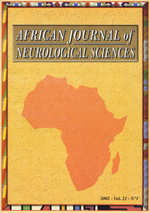
|
African Journal of Neurological Sciences
Pan African Association of Neurological Sciences
ISSN: 1015-8618
Vol. 20, Num. 1, 2001, pp. 39
|
Untitled Document
African Journal of Neurological Sciences, Vol. 20, No. 1, 2001, pp. 39
FACTORS INFLUENCING THE PRESENCE OF A TREATMENT BY ANTI-EPILEPTIC
DRUGS IN 811 EPILEPTIC PATIENTS FROM SIX AFRICAN COUNTRIES
Pierre-Marie Preux1,2, Michel Druet-Cabanac1,2, W Farid2,3,
Hamidou Traore2,4, Louis Dongmo2,5, Caroline Debrock1,2,
Dismand Houinato2,6, Micel Dumas1,2
1-Institute of Neuroepidemiology and Tropical Neurology, 2 rue du Dr Marcland,
87025 Limoges Cedex, France
2-Sub-saharan Africa Epilepsy Network
3-Department of Neuropsychiatry, Alexandria General Hospital Ras Etin, Alexandria,
Egypt
4-Department of Neurology, Neuropsychiatric Center, Nouakchott, Mauritania
5-Department of Neurology, Faculty of Medicine, Yaoundé, Cameroon
6-Department of Neurology, Faculty of Medicine, Cotonou, Benin
Corresponding author: Pierre-Marie Preux, Institut d'Epidémiologie Neurologique
et de Neurologie Tropicale, Faculté de Médicine, 2, rue du Docteur
Marcland, 87 025 Limoges. FRANCE. E-mail: preux@unilim.fr
Code Number: ns02011
A few studies about treatment by anti-epileptic drugs (AED) in Africa are available.
Furthermore, studies could not be compared because of the absence of standardisation
of the data collection phase. Threatment issues were assessed in 811 epileptic
patients included in six studies performed in Africa using the same standardised
Questionnaire for Investigation of Epilepsy in Tropical Countries, set up by
the Limoges Institute of Neuroepidemiology and Tropical Neurology and the Pan
African Association of Neurological Sciences (3). A part of this Questionnaire
is dedicated to the assessment of the treatment in a patient. The studies comprised
of two prevalence studies in Benin (1) and Cameroon (unpublished observations),
two case-control studies in Central African Republic (2) and Kenya (unpublished
observations), and two hospital based studies in Egypt (unpublished data) and
Mauritania (4) The statistical tests used were Pearson Chi-square, Fisher exact
test, and Mann-Whitney test.
The mean age of the patients was 24 ± 13 years. 54 % were males. 30% were
born in the study area. 80 % had a professional activity; among them 50 % were
farmers. A past history of epilepsy in the family was found in 25 % of the patients.
The epilepsy was categorized as symptomatic in 60 % of the cases. 20 % of all
the 811 patients were non treated by AED. This figure varies greatly among the
studies, higher in rural areas and in community surveys: 70 % in Benin, 50 %
in Central African republic, 20 % in Cameroun, 3 % in Kenya and Mauritania and
0.5 % in Egypt. 60 % of the cases were treated by AED only and 20 % were treated
by one drug, mainly phenobarbitone. The regularity of AED treatment was good
in 70 % of the cases. The principle reasons for irregularity were transient
inavailabilty (50 %) and lack of money (35 %). The efficacy of teh drugs was
very good as judged by patients and their family. 20 % reported mild side effects
from which 50 % of drowsiness.
The factors influencing whether a patient was treated by AED or not, were as
follows: high income (p<0.001), high level of education (p<0.001), living
in an urban area (P<0.001, to have had a status epilepticus (p<0.001),
an encephalitis (p<0.004) or a cranial trauma with loss of consciousness
(p<0.05), lead to an higher probability of treatmetn. Certain professional
activities, in particular being a farmer, are related to a decreasead probability
of AED treatment (p<0.001).
Despite the fact that the studies had various designs and were performed in
different areas, the power in the search of determining factors, is increased
by the inclusion of a high number of patients using the same data collection
tool. These results could help to understand the reasons of the huge treatment
gap in epilepsy in Africa.
References
- DEBROCK, C, PREUX PM, HOUINATO D, DRUET-CABANAC M, KASSA F, ADJIEN C
et al. Estimation of the prevalence of epilepsy in the Benin region of Zinvié
using capture-recapture method. Int J Epidemiol, 2000; 29:330-335.
- DRUET-CABANCA M, PREUX PM, BOUTEILLE B, BERNET-BERNADY P, DUNAND J, HOPKINS
A, et al. Onchocerciasis and epilepsy: a matched case-control study in Central
African Republic. Am J Epidemiol 1999; 149:565-70.
- PREUX PM, DRUET-CABANAC M, DEBROCK C, TAPIE, DUMAS M et le Comité
de recherche sur l'Epilepsie de l'Institut de Neurologie Tropicale de Limoges.
Questionnaire d'Investigation de l'Epilepsie en zone tropicale. Bull Soc Pathol
Exot. 2000; 93:276-278 et Suppl. 4.
- TRAORE H, DIAGANA M, DEBROCK C, BA A, AZQARD B, PREUX PM Approche socio-culturelle
de l'épilepsie en Mauritanie. Méd Trop 1998; 58365-8.
Copyright 2001 - African Journal of Neurological Sciences
|
